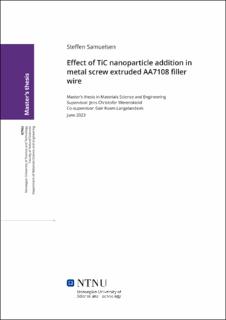| dc.contributor.advisor | Werenskiold, Jens Christofer | |
| dc.contributor.advisor | Kvam-Langelandsvik, Geir | |
| dc.contributor.author | Samuelsen, Steffen | |
| dc.date.accessioned | 2023-09-21T17:19:52Z | |
| dc.date.available | 2023-09-21T17:19:52Z | |
| dc.date.issued | 2023 | |
| dc.identifier | no.ntnu:inspera:140608939:34563495 | |
| dc.identifier.uri | https://hdl.handle.net/11250/3091186 | |
| dc.description.abstract | Bruken av nanokomposittsveisetråder har fått betydelig oppmerksomhet som et tiltak for å håndtere utfordringer forbundet med konvensjonell sveising av aluminium. I denne undersøkelsen ble en nanokompositt-tråd med sammensetning Al-1Ti-1.5TiC produsert ved hjelp av metallskrueekstrudering av AA7108 aluminiumslegering. For sammenligning ble det også produsert to andre sveisetråder uten Ti-TiC ved hjelp av stempelekstrudering (RE) og metallskrueekstrudering (SE). Inkorporering av nanopartikler i fylltråden resulterte i forbedrede sveiseegenskaper.
Dekkgassveising med smeltende elektrode (GMAW) og dekkgassveising med wolframelektrode (GTAW) ble brukt for å evaluere ytelsen til nanokomposittfylltrådene. Inokulanter ble introdusert i fyllmetallet ved å belegge aluminiumsbiter med Ti-partikler (ca. 5 μm) og TiC-nanopartikler (40-60 nm) før skrueekstruderingsprosessen. Det antas at partiklene var relativt jevnt fordelt i det ekstruderte materialet. Etter sveising ble tverrsnitt av sveisene undersøkt ved hjelp av et lysoptisk mikroskop (LOM), skanningelektronmikroskop (SEM), samt hardhets- og strekktesting.
Studien viste at inkluderingen av Ti- og TiC-partikler i aluminiumsfylltråden førte til en betydelig reduksjon i kornstørrelsen i både GMAW- og GTAW-sveisesmetallene. For GMAW ble kornstørrelsen redusert med henholdsvis 83% og 81% sammenlignet med sveiseskjøt fra stempelekstrudert (RE) og ren skrueekstrudert (SE) aluminiumstråd. Denne kornforfiningen tilskrives en økning i antall nukleeringspunkter, konstitusjonell underkjøling og hindring av kornvekst. Samtidig ble det observert en betydelig økning i porøsitet både i GMAW og GTAW ved tilsats av mikro- og nanopulver. Porøsitetsdannelsen kan forklares av ulike faktorer, som eksponering av pulveret for fuktighet og oksygen før skrueekstrudering, utilstrekkelige sveiseparametere og forurensning på overflatene til trådene.
Mekanisk testing viste ingen merkbar forskjell i hardhet mellom trådene for de individuelle sveismetodene. Det ble derimot observert betydelige forskjeller når man sammenlignet GMAW og GTAW. Økningen i hardhet i GMAW-prøvene tilskrives dannelse av GP(I)-soner. I tillegg ble to sett med 30 strekkprøver undersøkt med et 5 ukers mellomrom for å undersøke den generelle sveisstyrken og påvirkningen av kaldutherding. Sterkt varierende kvalitet på sveisene førte til uregelmessige testprøver, noe som resulterte i store styrkeforskjeller mellom GMAW- og GTAW-sveiseskjøtene. | |
| dc.description.abstract | The utilization of nanocomposite filler wires has gained considerable attention in order to address the challenges associated with conventional aluminium welding. In the present investigation, a nanocomposite filler wire with composition Al-1Ti-1.5TiC was produced using metal screw extrusion of AA7108 feedstock material. To compare, two other filler wires of plain ram extruded (RE) and metal screw extruded (SE) were fabricated. Incorporating nanoparticles into the filler wire resulted in improved weldability.
Gas metal arc welding (GMAW) and gas tungsten arc welding (GTAW) were used to assess the performance of the nanocomposite filler wire. The introduction of inoculants into the filler metal was accomplished by coating aluminium pellets with Ti particles (∼5 μm) and TiC nanoparticles (40-60 nm) prior to the extrusion process. It is presumed that the particles were fairly uniformly distributed within the extruded material. Following welding, transverse cross-sections of the welds were examined using a light optical microscope (LOM), scanning electron microscope (SEM), in addition to hardness and tensile testing.
The study revealed that the inclusion of Ti and TiC particles in the aluminium filler wire led to a significant reduction in the grain size of both GMAW and GTAW weld metals. For GMAW, the grain size decreased by 83% and 81% compared to welds with ram extruded (RE) and plain metal screw extruded (SE) aluminium wire, respectively. This grain refinement is likely attributed to an increased number of nucleation points, extensive constitutional undercooling, and constraints on grain growth. Meanwhile, a notable increase in porosity was observed in both GMAW and GTAW SE with the addition of Ti/TiC powder. The introduction of porosity is explained by various factors, such as exposing the powder to moisture and oxygen before screw extrusion, improper welding parameters, and contamination of the filler wire surfaces.
Mechanical testing found no appreciable hardness difference between the wires for the individual welding methods. Conversely, a great variation was observed when comparing GMAW and GTAW. The hardness increase in the GMAW samples is attributed to the formation of GP(I) zones. Additionally, two batches of 30 tensile test specimens were examined at a 5-week interval to investigate the general weld strength and the impact of natural aging. Considerable variations in weld quality resulted in irregular test specimens, leading to significant strength differences between the GMAW and GTAW welds. | |
| dc.language | eng | |
| dc.publisher | NTNU | |
| dc.title | Effect of TiC nanoparticle addition in metal screw extruded AA7108 filler wire | |
| dc.type | Master thesis | |
